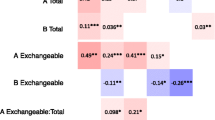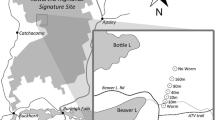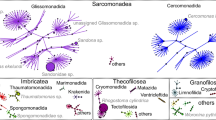Abstract
Recent studies document North American earthworm invasions and their profound effects on the structure of the soil profile, which is the habitat for soil microorganisms (mainly fungi and bacteria). Dramatic alterations made to these layers during earthworm invasion significantly change microbial community structure and therefore microbial activities such as C transformations. Understanding the impacts of earthworm invasion on the microbes themselves will give insight into earthworm effects on microbial activities. Bacterial and actinomycete communities in earthworm guts and casts have not been studied in environments recently invaded by earthworms. Earthworm invasion tended to decrease fungal species density and fungal species diversity and richness. The presence of earthworms decreased zygomycete species abundance probably due to disruption of fungal hyphae. Physical disruption of hyphae may also explain decreased mycorrhizal colonization rates, decreased mycorrhizal abundance and altered mycorrhizal morphology in the presence of earthworms. Mixing of organic layers into mineral soil during earthworm invasion tended to decrease microbial biomass in forest floor materials while increasing it in mineral soil. In newly invaded forest soils, microbial respiration and the metabolic quotient tended to decline. In forests where either the microbial community has had time to adapt to earthworm activities, or where the destruction of the forest floor is complete, as in invasions by the Asian Amynthas hawayanus, the presence of earthworms tends to increase the metabolic quotient indicating a shift to a smaller, more active microbial community.
Similar content being viewed by others
References
Adu JK, Oades JM (1978) Utilization of organic materials in soil aggregates by bacteria and fungi. Soil Biol Biochem 10:117–122
Alban DH, Berrry EC (1994) Effects of earthworm invasion on morphology, carbon and nitrogen of a forest soil. Appl Soil Ecol 1:243–249
Altas RM, Bartha R (1998) Microbial ecology: fundamentals and applications. Addison Wesley Longman, Menlo Park, pp 694
Bohlen PJ, Groffman, PM, Fahey TJ, Fisk MC, Suárez E, Pelletier DM, Fahey RT (2004a) Ecosystem consequences of exotic earthworm invasion of north temperate forests. Ecosystems 7:1–12
Bohlen PJ, Pelletier DM, Groffman PM, Fahey TJ, Fisk MC (2004b) Influence of earthworm invasion on redistribution and retention of soil carbon and nitrogen in northern temperate forests. Ecosystems 7:13–27
Brady NC, Weil RR (2002) The nature and properties of soils, 13th edn. Prentice-Hall, Upper Saddle River, NJ, pp 960
Brown GG, Barois I, Lavelle P (2000) Regulation of soil organic matter dynamics and microbial activity in the drilosphere and the role of interactions with other edaphic functional domains. Euro J Soil Biol 36:177–198
Buckley DH, Schmidt TM (2002) Exploring the biodiversity of soil—a microbial rain forest. In: Staley JT, Reysenback A-L (eds) Biodiversity of microbial life. Wiley-Liss, New York, pp 183–208
Burtelow AE, Bohlen PJ, Groffman PM (1998) Influence of exotic earthworm invasion on soil organic matter, microbial biomass and denitrification potential in forest soils of the northeastern United States. Appl Soil Ecol 9:197–202
Caravaca F, Roldán A (2003) Effect of Eisenia foetida earthworms on mineralization kinetics, microbial biomass, enzyme activities, respiration and labile C fractions of three soils treated with a composted organic residue. Biol Fertil Soils 38:45–51
Carlile MJ, Watkinson SC, Gooday GW (2001) The fungi. Academic Press, San Diego, pp 588
Coleman DC, Crossley DA (1996) Fundamentals of soil ecology. Academic Press, San Diego, pp 205
Daane LL, Molina JAE, Sadowsky MJ (1997) Plasmid transfer between spatially separated donor and recipient bacteria in earthworm-containing soil microcosms. Appl Environ Microbiol 63:679–686
Dash MC, Mishra PC, Behera N (1979) Fungal feeding by a tropical earthworm. Trop Ecol 20:9–12
Davey ME, O’Toole GA (2000) Microbial biofilms: from ecology to molecular genetics. Microbiol Mol Biol Rev 64:847–867
Doube BM, Ryder MH, Davoren CW, Meyer T (1995) Earthworms: a down-under delivery service for biocontrol agents of root disease. Acta Zool Fennica 196:219–223
Edwards CA, Bohlen PJ (1996) Biology and Ecology of Earthworms. Chapman and Hall, London, pp 426
Edwards CA, Fletcher KE (1988) Interactions between earthworms and microorganisms in organic matter breakdown. Agricul Ecosys Environ 24:235–247
Fisk MC, Fahey TJ, Groffman PM, Bohlen PJ (2004) Earthworm invasion, fine-root distributions, and soil respiration in north temperate forests. Ecosystems 7:55–62
Gange AC (1993) Translocation of mycorrhizal fungi by earthworms during early succession. Soil Biol Biochem 25:1021–1026
Görres JH, Savin MC, Amador JA (1997) Dynamics of carbon and nitrogen mineralization, microbial biomass, and nematode abundance within and outside the burrow walls of anecic earthworms (Lumbricus terrestris). Soil Sci 162:666–671
Groffman PM, Bohlen PJ, Fisk MC, Fahey TJ (2004) Exotic earthworm invasion and microbial biomass in temperate forest soils. Ecosystems 7:45–54
Gunnarsson T, Sundin P, Tunlid A (1988) Importance of leaf litter fragmentation for bacterial growth. Oikos 52:303–308
Haimi J, Huhta V (1990) Effects of earthworms on decomposition processes in raw humus forest soil: a microcosm study. Biol Fertil Soils 10:178–183
Hale CM (2004) Ecological consequences of exotic invaders: interactions involving European earthworms and native plant communities in hardwood forests, PhD Dissertation, University of Minnesota. St. Paul, MN
Harinikumar KM, Bagyaraj DJ (1994) Potential of earthworms, ants, millipedes and termites for dissemination of vesicular-arbuscular mycorrhizal fungi in soil. Biol Fertil Soils 18:115–118
Haynes RJ, Fraser PM, Tregurtha RJ, Piercy JE (1999) Size and activity of the microbial biomass and N, S and P availability in earthworm casts derived from arable and pasture soil and arable soil amended with plant residues. Pedobiologia 43:568–573
Hutchinson SA, Kamel M (1956) The effect of earthworms on the dispersal of soil fungi. J Soil Sci 7:213–218
Jones MD, Durall DM, Harniman SMK, Classen DC, Simard SW (1997) Ectomycorrhizal diversity on Betula papyrifera and Pseudotsuga menziesii seedlings grown in the greenhouse or outplanted in single-species and mixed plots in southern British Columbia. Can J Forest Res 27:1872–1889
Karsten GR, Drake HL (1997) Denitrifying bacteria in the earthworm gastrointestinal tract and in vivo emission of nitrous oxide (N2O) by earthworms. Appl Environ Microbiol 63:1878–1882
Khambata SR, Bhat JV (1957) A contribution to the study of the intestinal microflora of Indian earthworms. Archiv für Mikrobiologie 28:69–80
Kristufek V, Pizl V, Szabó IM (1990) Composition of the intestinal Streptomycete community of earthworms (Lumbricidae). In: Lésel R (ed) Microbiology in poicilotherms. Elsevier Science Publishers, pp 137–140
Kristufek V, Ravasz K, Pizl V (1992) Changes in densities of bacteria and microfungi during gut transit in Lumbricus rubellus and Aporrectodea caliginosa (Oligochaeta: Lumbricidae). Soil Biol Biochem 24:1499–1500
Kristufek V, Ravasz K, Pizl V (1993) Actinomycete communities in earthworm guts and surrounding soil. Pedobiologia 37:379–384
Kristufek V, Tajovský K, Pizl V (1994) Ultrastructural analysis of the intestinal content of earthworm Lumbricus rubellus Hoffm. (Annelida, Lumbricidae) Acta Microbiologica et Immunologica Hungarica 41:283–290
Lattaud C, Locati S, Mora P, Rouland C, Lavelle P (1998) The diversity of digestive systems in tropical geophagous earthworms. Appl Soil Ecol 9:189–195
Lavelle P, Spain AV (2001) Soil Ecology. Kluwer Academic Publishers, Dordrecht, pp 654
Lawrence B, Fisk MC, Fahey TJ, Suárez ER (2003) Influence of nonnative earthworms on mycorrhizal colonization of sugar maple (Acer saccharum). New Phytol 157:145–153
Makulec G (2002) The role of Lumbricus rubellus Hoffm. in determining biotic and abiotic properties of peat soils. Polish J Ecol 50:301–339
Márialigeti K (1979) On the community structure of the gut microbiota of Eisenia lucens (Annelida, Oligochaeta). Pedobiologia 19:213–220
Mba C (1997) Rock phosphate solubilizing Streptosporangium isolates from casts of tropical earthworms. Soil Biol Biochem 29:381–385
McLean MA, Parkinson D (1997a) Changes in structure, organic matter and microbial activity in pine forest soil following the introduction of Dendrobaena octaedra (Oligochaeta, Lumbricidae). Soil Biol Biochem 29:537–540
McLean MA, Parkinson D (1997b) Soil impacts of the epigeic earthworm Dendrobaena octaedra on organic matter and microbial activity in lodgepole pine forest soil. Can J Forest Res 27:1907–1913
McLean MA, Parkinson D (1998) Impacts of the epigeic earthworm Dendrobaena octaedra on microfungal community structure in pine forest floor: a mesocosm study. Appl Soil Ecol 8:61–75
McLean MA, Parkinson D (2000) Field evidence of the effects of the epigeic earthworm Dendrobaena octaedra on the microfungal community in pine forest floor. Soil Biol Biochem 32:351–360
Migge S. (2001) The effect of earthworm invasion on nutrient turnover, microorganisms and microarthropods in Canadian aspen forest soil. Ph.D. Thesis, Technische Universität Darmstadt. Cuvillier Verlag, Göttingen
Moody SA, Piearce TG, Dighton J (1996) Fate of some fungal spores associated with wheat straw decomposition on passage through the guts of Lumbricus terrestris and Aporrectodea longa. Soil Biol Biochem 28:533–537
Orazova MK, Semenova TA, Tiunov AV (2003) The microfungal community of Lumbricus terrestris middens in a linden (Tilia cordata) forest. Pedobiologia 47:27–32
Parle JN (1963a) A microbiological study of earthworm casts. Journal of general Microbiology 31:13–22
Parle JN (1963b) Micro-organisms in the intestines of earthworms. J Gen Microbiol 31:1–11
Patron JC, Sanchez P, Brown GG, Brossard M, Barois I, Gutiérrez C (1999) Phosphorus in soil and Brachialis decumbens plants as affected by the geophagous earthworm Pontoscolex corethrurus and P fertilization. Pedobiologia 43:547–556
Pattinson GS, Smith SE, Doube BM (1997) Earthworm Aporrectodea trapezoides had no effect on the dispersal of a vesicular-arbuscular mycorrhizal fungi, Globus intraradices. Soil Biol Biochem 29:1079–1088
Pedersen JC, Hendriksen NB (1993) Effect of passage through the intestinal tract of detritivore earthworms (Lumbricus spp.) on the number of selected Gram-negative and total bacteria. Biol Fertil Soil 16:227–232
Ponge JC (1991) Food resources and diets of soil animals in a small area of Scots pine litter. Geoderma 49:33–62
Prat P, Charrier M, Deleporte S, Frenot Y (2002) Digestive carbohydrases in two epigeic earthworm species of the Kerguelen Islands (Subantarctic). Pedobiologia 46:417–427
Reddell P, Spain AV (1991) Earthworms as vectors of viable propagules of mycorrhizal fungi. Soil Biol Biochem 23:767–774
Reynolds JW (1973) The earthworms of Rhode Island (Oligochaeta: Lumbricidae). Megadrilogica 1:1–4
Reynolds JW (2002) Additional earthworm (Oligochaeta: Lumbricidae and Megascolescidae) records from Rhode Island, USA. Megadrilogica 9:21–27
Saetre P (1998) Decomposition, microbial community structure, and earthworm effects along a birch-spruce soil gradient. Ecology 79:834–846
Sakamoto K, Oba Y (1994) Effect of fungal to bacterial biomass ratio on the relationship between CO2 evolution and total soil microbial biomass. Biol Fertil Soils 17:39–44
Scheu S (1987) Microbial activity and nutrient dynamics in earthworm casts (Lumbricidae). Biol Fertil Soils 5:230–234
Scheu S (1991) Mucus excretion and carbon turnover of endogeic earthworms. Biol Fertil Soil 12:217–220
Scheu S, Parkinson D (1994a) Effects of earthworms on nutrient dynamics, carbon turnover and microorganisms in soils from cool temperate forests of the Canadian Rocky Mountains—laboratory studies. Appl Soil Ecol 1:113–125
Scheu S, Parkinson D (1994b) Effects of invasion of an aspen forest (Canada) by Dendrobaena octaedra (Lumbricidae) on plant growth. Ecology 75:2348–2361
Scheu S, Parkinson D (1995) Successional changes in microbial biomass, respiration and nutrient status during litter decomposition in an aspen and pine forest. Biol Fertil Soils 19:327–332
Scheu S, Schlitt N, Tiunov AV, Newington JE, Jones TH (2002) Effects of the presence and community composition of earthworms on microbial community functioning. Oecologia 133:254–260
Shankar SG, Ranganathan S, Ranjith MS, Vijayalakshmi GS (2002) Did earthworms contribute to the parasitic evolution of dermatophytes? Mycoses 45:399–401
Shaw C, Pawluk S (1986) Faecal microbiology of Octolasion tyrtaeum, Aporrectodea turgida and Lumbricus terrestris and its relation to the carbon budgets of three artificial soils. Pedobiologia 29:377–389
Subler S, Kirsch AS (1998) Spring dynamics of soil carbon, nitrogen, and microbial activity in earthworm middens in a no-till corn field. Biol Fertil Soils 26:243–249
Swift MJ, Heal OW, Anderson JM (1979) Decomposition in terrestrial ecosystems. University of California Press, Berkeley, pp 372
Thorpe IS, Killham K, Prosser JI, Glover LA (1993) Novel method for the study of the population dynamics of a genetically modified microorganism in the gut of the earth worm Lumbricus terrestris. Biol Fert Soils 15:55–59
Tiunov AV, Scheu S (1999) Microbial respiration, biomass, biovolume and nutrient status in burrow walls of Lumbricus terrestris L. (Lumbricidae). Soil Biol Biochem 31:2039–2048
Tiunov AV, Scheu S (2000a) Microbial biomass, biovolume and respiration in Lumbricus terrestris L. cast material of different age. Soil Biol Biochem 32:265–275
Tiunov AV, Scheu S (2000b) Microfungal communities in soil, litter and casts of Lumbricus terrestris L. (Lumbricidae): a laboratory experiment. Appl Soil Ecol 14:17–26
Tiunov AV, Bonkowski M, Alphei J, Scheu S (2001) Microflora, Protozoa and Nematoda in Lumbricus terrestris burrow walls: a laboratory experiment. Pedobiologia 45:46–60
Tiwari SC, Mishra RR (1993) Fungal abundance and diversity in earthworm casts and in uningested soil. Biol Fertil Soil 16:131–134
Toyota K, Kimura M (2000) Microbial community indigenous to the earthworm Eisenia foetida. Biol Fertil Soils 31:187–190
Tuffen F, Eason WR, Scullion J (2002) The effect of earthworms and arbuscular mycorrhizal fungi on growth of and 32P transfer between Allium porrum plants. Soil Biol Biochem 34:11027–1036
Urbášek F (1990) Cellulase activity in the gut of some earthworms. Revue d’Éologie et du Biologie du Sol 27:21–28
Welke SE, Parkinson D (2003) Effect of Aporrectodea trapezoides activity on seedling growth of Pseudotsuga menziesii, nutrient dynamics and microbial activity in different soils. Forest Ecol Manag 173:169–186
Whitman WB, Coleman DC, Wiebe WJ (1998) Prokaryotes: the unseen majority. Proc Natl Acad Sci, USA 95:6578–6583
Wolter C, Scheu S (1999) Changes in bacterial numbers and hyphal lengths during the gut passage through Lumbricus terrestris (Lumbricidae, Oligochaeta). Pedobiologia 43:891–900
Wolters V, Joergensen RG (1992) Microbial carbon turnover in beech forest soils worked by Aporrectodea caliginosa (Savigny) (Oligochaeta: Lumbricidae). Soil Biol Biochem 24:171–177
Wurst S, Dugassa-Gobena D, Langel R, Bonkowski M, Scheu S (2004) Combined effects of earthworms and vesicular-arbuscular mycorrhizas on plant and aphid performance. New Phytol 163:169–173
Zhang BG, Rouland C, Lattaud C, Lavelle P (1993) Activity and origin of digestive enzymes in gut of the tropical earthworm Pontoscolex corethrurus. Euro J␣Soil Biol 29:7–11
Zhang B-G, Li G-T, Shen T-S, Wang J-K, Sun Z (2000) Changes in microbial biomass C, N and P and enzyme activities in soil incubated with the earthworms Metaphire guillelmi and Eisenia fetida. Soil Biol Biochem 32:2055–2062
Acknowledgments
We thank Peter Groffman, Institute of Ecosystem Studies, and an anonymous reviewer whose comments improved the manuscript.
Author information
Authors and Affiliations
Corresponding author
Rights and permissions
About this article
Cite this article
McLean, M., Migge-Kleian, S. & Parkinson, D. Earthworm invasions of ecosystems devoid of earthworms: effects on soil microbes. Biol Invasions 8, 1257–1273 (2006). https://doi.org/10.1007/s10530-006-9020-x
Published:
Issue Date:
DOI: https://doi.org/10.1007/s10530-006-9020-x




